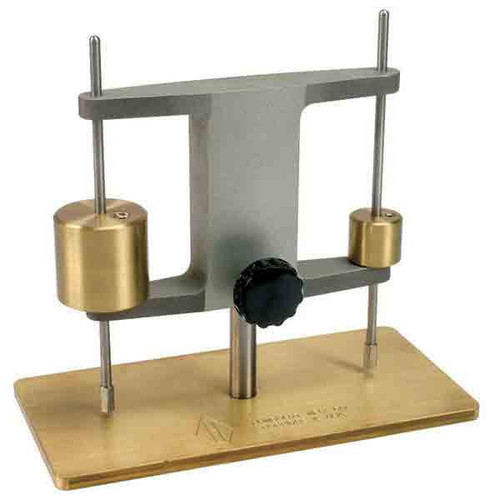Gillmore Needle Apparatus
Gillmore Needle Apparatus is used to determine initial and final set times of Portland cement, masonry cement, hydraulic hydrated lime, and certain mortars in accordance with ASTM C266 and other standards. The adjustable support has horizontal arms to guide two weighted needles with flat-end cylindrical stainless steel tips. The base has an ample flat shelf for positioning specimens. In testing the molded specimen for the time of setting, the initial-set needle is 1/4lb (113.4g) and 1/12in (2.12mm) diameter. Final-set needle is 1lb (453.6g) and 1/24in (1.06mm) diameter.
Features:
- Meets several ASTM and AASHTO test methods for set-time testing
- Includes initial and final-set needles
- Large base to position specimens
Meets Test Methods:
AASHTO T 154 , ASTM C266 , ASTM C414 , ASTM C150/150M , ASTM C91/91M
Browse Certified MTP for all of your cement test equipment needs like cube molds for concrete, cement, mortar, and grout as well as Final Set Time of Cement products and ASTM C266 Standards for Cement Tests
The Gillmore needle apparatus is a widely used tool in cement testing to determine the initial and final setting times of cement. It provides valuable information about the time required for cement paste to transition from a plastic, workable state to a hardened state. This information is essential for various construction applications, as it helps determine the optimal time for various operations, such as mixing, placing, and finishing concrete.
The Gillmore needle apparatus consists of two needles—a reference needle and a test needle—and a needle holder. The cement paste, prepared by mixing cement with water according to specified proportions, is placed in a mold and leveled. The needles are then placed on the surface of the paste. The test needle is released and allowed to freely penetrate into the paste, while the reference needle remains stationary. The penetration depths of both needles are measured and recorded at regular time intervals.
The initial setting time is defined as the time at which the test needle ceases to make a perceptible impression on the cement paste. It indicates the point at which the cement begins to lose its plasticity and starts to harden. The final setting time is the time at which the test needle fails to penetrate the paste, indicating the completion of the hardening process.
The results obtained from the Gillmore needle apparatus help engineers, researchers, and manufacturers evaluate the setting characteristics of different cement types, assess the impact of various factors such as temperature and admixtures, and optimize concrete mix designs. It aids in quality control during cement production, enables the selection of appropriate cement for specific applications, and ensures compliance with industry standards and specifications.
In summary, the Gillmore needle apparatus is a valuable tool in cement testing, providing critical information about the initial and final setting times of cementitious materials. It allows for precise timing of construction operations, assists in quality control, and contributes to the performance and durability of concrete structures.


